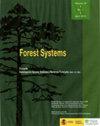Evaluating the current ecological status and proposing rehabilitation interventions for the low flooded riparian reserve forest in Punjab Pakistan
IF 0.7
4区 农林科学
Q3 FORESTRY
引用次数: 3
Abstract
Aim of Study: The complex community of riparian reserve forest has become of great concern for researchers to develop more viable management strategies. The paper aimed to evaluate the current structural diversity of vegetation and its association with the physical environment of low-lying forest for proposing the rehabilitation interventions. Area of Study: We studied two forests, Chung-Mohlanwal and Dhana-Bheni on both riverbanks along river Ravi in the Jhok riparian reserve forest situated in the southwest of Lahore, Pakistan.Material and Methods: A methodological framework was developed based firstly, on direct comparison of diversity (measured by Hill numbers) and structure of existed vegetation layers (trees, shrubs, herbs, and grasses) and environmental factors (canopy structure, anthropogenic activities, microclimate, and soil characteristics) between the two forests and secondly, on environment-vegetation association using Canonical Correspondence Analysis (CCA) ordination method.Results: Dhana forest was more diverse vegetation layers (Shannon Diversity index 1D < 11) and intact due to plantation of uneven-aged tree stands of varied stand basal area and stem density. Microclimate under this forest could not support the dominant understory positively unlike the monoculture forest. On the contrary, Chung-Mohlanwal forest was under the influence of uncontrolled grazing activities, fuelwood extraction, and invasive species. Multivariate analysis CCA elucidated that most variance was shown by soil characteristics (38.5 %) for understory vegetation in both forests.Research Highlights: Overstory stand structure, species composition, distance to nearby communities, and soil characteristics should be considered for developing forest planting and management strategies.Keywords: Vegetation Structure; Hill Numbers; Grazing; Environment; Management.Abbreviation used: CCA (Canonical Correspondence Analysis); 1D (Shannon Diversity); Ca + Mg (Calcium + Magnesium); Na (Sodium); ECe (Electrical Conductivity); DBH (Diameter at Breast Height); IUCN (International Union for Conservation of Nature); SBA (Stand Basal area); BA (Basal Area); 0D (Richness); 2D (Simpson Index); IVI (Importance Value Index); LU (Livestock Unit); GPS (Global Positioning System); OC (Organic Carbon); OM (Organic matter); SAR (Sodium Adsorption Ratio); N (Nitrogen); P (Phosphorous); K (Potassium); DCA (Detrended Correspondence Analysis); S (Shrub); H (Herb); G (Grass).评估巴基斯坦旁遮普邦低淹没河岸保护林的当前生态状况并提出恢复干预措施
研究目的:河岸保护区的复杂群落已成为研究人员非常关注的问题,需要制定更可行的管理策略。本文旨在评价低洼森林植被结构多样性现状及其与自然环境的关系,为低洼森林植被恢复提供参考。研究领域:我们研究了位于巴基斯坦拉合尔西南部的Jhok河岸保护区拉维河两岸的两个森林,Chung-Mohlanwal和Dhana-Bheni。材料和方法:首先,通过直接比较两种森林之间现有植被层(乔木、灌木、草本和禾草)的多样性和结构以及环境因子(冠层结构、人为活动、小气候和土壤特征),其次,利用典型对应分析(CCA)排序方法建立环境-植被关联的方法框架。结果:达纳林的植被层更加多样化(Shannon多样性指数1D < 11),且由于人工林的树龄不均匀、林分基面积和茎密度不同而较为完整。与单作林不同,该林下的小气候对优势林下的支持不明显。相反,Chung-Mohlanwal森林受到放牧活动、薪柴开采和入侵物种的影响。多变量分析表明,土壤特征对林下植被的影响最大(38.5%)。研究重点:在制定森林种植和管理策略时应考虑林分结构、物种组成、与附近群落的距离和土壤特征。关键词:植被结构;希尔数字;放牧;环境;管理。使用缩写:CCA(规范对应分析);1D (Shannon Diversity);Ca + Mg(钙+镁);Na(钠);ECe(电导率);胸径(胸围直径);国际自然保护联盟;SBA(林基面积);BA(基底面积);0 d(丰富);2D (Simpson指数);IVI(重要性值指数);助理主任(畜牧组);全球定位系统;OC(有机碳);有机质;钠吸附比;N(氮);P(磷);K(钾);非趋势对应分析;年代(灌木);H(草);G(草)。
本文章由计算机程序翻译,如有差异,请以英文原文为准。
求助全文
约1分钟内获得全文
求助全文
来源期刊

Forest Systems
FORESTRY-
CiteScore
1.40
自引率
14.30%
发文量
30
审稿时长
6-12 weeks
期刊介绍:
Forest Systems is an international peer-reviewed journal. The main aim of Forest Systems is to integrate multidisciplinary research with forest management in complex systems with different social and ecological background
 求助内容:
求助内容: 应助结果提醒方式:
应助结果提醒方式:


